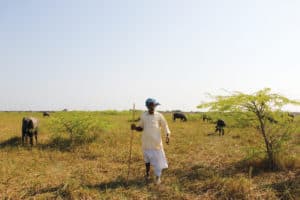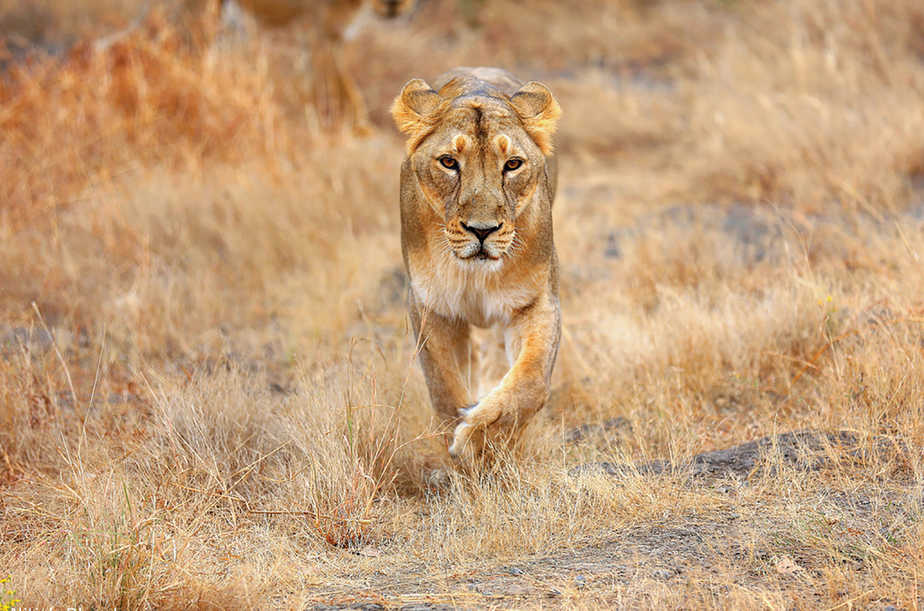The Asiatic lion has only one habitat in the world – Gujarat’s Gir National Park where 23 lions have died in less than a month. This calls for immediate steps to repopulate the endangered species in an alternative abode
The only surviving population of the Asiatic lion resides in Gujarat’s Gir National Park (GNP)—Prime Minister Narendra Modi’s home state. The Asiatic lion is the face of the Make in India campaign. Ironically, in Gujarat, there’s a total ban on cow slaughter, but Gujarat’s lions are beef eaters—their staple diet is cow and buffalo reared by the local Maldhari tribe.
The latter don’t mind lions preying on their cattle, as the compensation is good; their presence is considered divine. Perhaps, that’s why their numbers have risen to 543 (barely a dozen left in the wild 100 years ago), which is unmanaged given the limited prey-base and the area of GNP—1,412 sq kms.
In less than a month, 23 lions have reportedly died in the Sarasiya Vidi area, a reserved forest in the Dalkhaniya range of GNP. At least four of them were found to be infected with a deadly canine distemper virus (CDV). Gujarat’s forest and animal husbandry departments have launched a joint operation to vaccinate dogs and cattle in the surrounding area to contain the spread of this deadly virus. The forest department has also initiated vaccination of some of the lions which were rescued from the Shemardi area and are kept under observation.
Nearly half of the lion population, as per the experts residing locally, live outside the protected area, alongside human habitations, or on the revenue land. They have spread far and wide, all over the Saurashtra, from Jamnagar to Bhavnagar. A few years ago, an incident of a man-eating lion was reported from Ambariya village, which is some hundred kilometres from the periphery of GNP. It is not unsual to sight a pride of lions crossing a highway or walking along a road in the vicinity of a city or a village in the evening, or sitting in the shade close to aMaldhari hamlet during a hot day.
Even though it is a healthy population, it is limited to a single habitation. Since many years, environmentalists have been warning, saying that this situation is akin to putting all eggs in one basket, albeit, in this case, the basket is really big. Therefore, it makes perfect ecological sense to create two or more populations of Asiatic lion in a different habitation, so that the entire population won’t be wiped out in case of an epidemic or due to any other reason. Also, the problem of plenty makes their relocation imperative. But Modi for many years, as the chief minister of Gujarat, assiduously opposed and scuttled any move to relocate lions out of Gujarat to protected areas in other states. Lions are the pride of Gujarat, and only Gujarat.
For instance, Kuno Wildlife Sanctuary in Madhya Pradesh, is waiting for lions for more than a decade now, after 24 villages of Sahariya tribe were moved out to create a pristine habitat for lions. Gujarat lost an 8-year long legal battle to shift lions. Soon after Modi was sworn in as the Prime Minister, in one of the very first communiqués, the BJP-government of Madhya Pradesh sent a proposal to the Union Ministry of Environment and Forest, seeking a budgetary allocation of Rs 79 crore to shift some lions out of GNP to Kuno. Of course, nothing happened.
Any move or demand to rationalise lion population, in other words, to relocate, is scuttled. The recent deaths of lions indicate that these fears are not misplaced, a deadly contagious disease can wipe out the whole population of Asiatic lions.
One of the fears against shifting lions out of Gujarat is that unlike tigers, lions in GNP are fairly comfortable with local tribes and vice versa. While reporting in Gujarat two years ago, this reporter took an exhaustive drive of three hours inside the forest on a muddy road with potholes the size of a bathtub, to Aankol Vadi. It’s one of the 54 hamlets inside the core area of GNP —locally called ness—that houses one extended family of the Maldhari tribe with their livestock. Legally, the core area is supposed to be pristine, devoid of human presence and activities.
In this particular ness lives the extended family of Kanha Bhai Appa Bhai Gadhavi—the undisputed leader of the Maldhari tribe since decades. There’s no power supply, instead solar lamps are installed on bamboo poles. A diesel pump draws water from a well downhill. An extended, open enclosure, lined with a six-feet mud wall, is located on top of a hill. Inside the enclosure live some 200 buffalo in the middle of a forest full of lions.

The Gadhavi family has been living there since generations — their dominance in the area is no less than that of lions. So much is their influence, that Modi, Keshubhai Patel and other chief ministers in the past, have paid a visit to seek the support of this community during elections.
Vijay’s son, Subhash, who had just passed out of school, spoke perfect Hindi, making him a trusted interpreter. “We invite people, tourists also, to sight a lion, as the pride stays with the kill for a few days.” Lions don’t kill for greed, they do it only when hungry. And human presence does not bother them. Here, the predator and humanity have learned to live in perfect harmony.
Gadhavis have given names to some of the lions, as if they are their pets. Tiliya is the biggest lion they ever saw, it was as big as a buffalo. They are worried as “the numbers of lions have grown, but the forest is shrinking. Lions need our presence, they are dependent on us (Maldharis),” explains Vijay in Gujarati, adding, “We ensure easy food to these lazy predators,” In fact, he claims, lions also leave that forest area when Maldharis are forcefully evicted and relocated.
Lion expert and a fellow with the Wildlife Institute of India, Kaushik Banerjee, has carried out extensive field work for eight years in the Gir forests. He speaks the local dialects like natives, but doesn’t agree with Vijay’s optimism. “If the ecology of the forest is to be conserved, Maldharis will have to be moved out,” he says. He’s in favour of relocation of lions to increase the genetic pool.
‘I believe that the lions were irresistible and magical creatures and an alien imposter in the land of the tiger—a natural world that he didn’t know or belong,’ writes Valmik Thapar, environmentalist and author, in his celebrated book Exotic Aliens that he co-authored with Romila Thapar and Yusuf Ansari.
The pride of Gujarat—the prides of lions— which is becoming a potent symbol of nationalism, might not be Indian at all. Thapar describes Gujarat’s pride as the ‘khichdi lion’—a curious mix of North American and the so-called Asiatic lion.
In medieval times, the western coast of Gujarat was the landing ground, where the imported cheetahs and lions from Africa were quarantined and acclimatised to the new environment, almost domesticated, before they were released in the wild for the kings and nobility to indulge in hunting . The Indian lion is known for its tameness, docility and inability to behave as a predator in the wild; also its coyness with humans.
By 1900, 15-20 lions of the ‘mongrel pack’, as Valmik describes them, were left in the Gir forests, half-fed and half–reared. It is thanks to the Nawab of Junagarh and later, the Gujarat government, that we have a large crop of docile wild lions in Gujarat.
Perhaps, in this second crisis, which is a potential threat to the lion population, ecological prudence is required, and not misplaced sentimentality.





